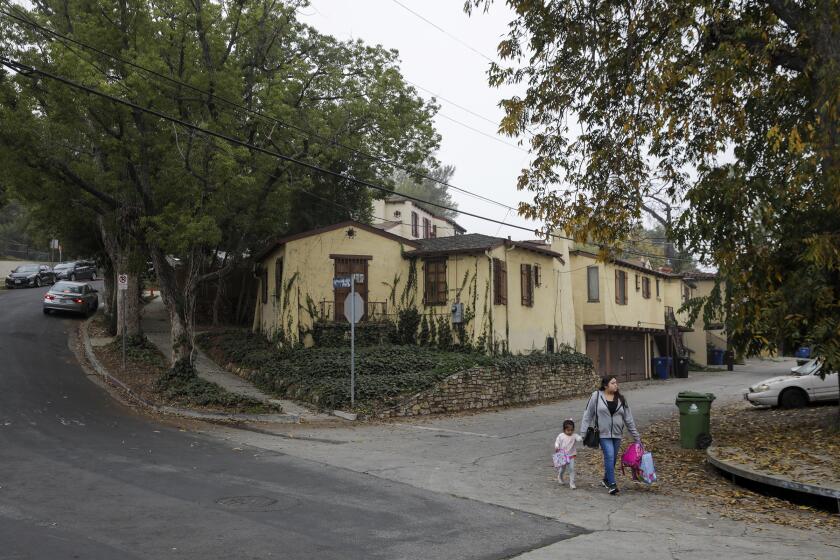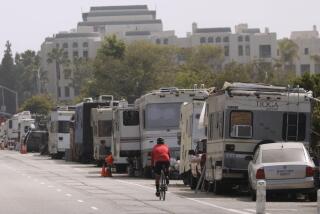California bans mandated parking near transit to fight high housing prices, climate change

Citing the need to address California’s twin crises of housing affordability and climate change, Gov. Gavin Newsom signed a bill that bars local governments from mandating parking spaces as part of most development near transit stops.
Critics say the new law could backfire, but supporters argue that by eliminating a costly piece of new projects, Assembly Bill 2097 will result in lower-cost homes in urban centers, a plus in a state with sky-high home prices, rents and a growing homeless population.
“This is one of the biggest land-use reforms in the country,” said Michael Manville, an urban planning professor at UCLA’s Luskin School of Public Affairs, adding that only Oregon has done something similar.
In signing the bill Thursday, Newsom emphasized its potential environmental benefits as well. With more housing in walkable neighborhoods with public transit, he said climate change-inducing car trips will be reduced.
“Housing solutions are also climate solutions,” the governor said.
When the bill, authored by Assemblywoman Laura Friedman (D-Glendale), becomes law in January, parking minimums will no longer be allowed for housing, retail and other commercial developments within a half-mile of major public transit stops.
Cities can impose parking for hotel developments, and developers can still build parking spaces for any type of project if they choose to.
The survey found that nearly 55% of Californians were concerned about being able to pay their rents or mortgages, with 26% very concerned.
Although the bill isn’t limited to housing projects, much of the debate focused on AB 2097’s impact to affordability given the Golden State’s housing crisis.
A wide body of research indicates that adding new housing — even market rate — puts downward pressure on home prices and rents on a regional level, though it’s less clear what happens in the blocks next to a new development.
Housing developers say it can cost tens of thousands of dollars for each parking stall, and parking requirements have forced them to kill projects altogether, or build fewer homes than they otherwise could.
“This bill will give developers flexibility to bring cost down for renters,” Friedman said. “It gives renters more options and allows them to self-select if they want to have less cars and use transit for a reduced rent.”
The effects of the new law could be minimal at first, in part because banks may initially be skeptical of lending to projects without parking. But in the long run, Manville said he expects it to lead to an increase in housing supply and cheaper units for those who don’t want a parking space.
Michael Schneider, executive director of Streets for All, said he hopes developers take advantage because people need to be incentivized to use Los Angeles’ Metro system, which is undergoing a multibillion-dollar expansion, including extending the Purple Line, also known as the D Line, to connect the Westside to downtown L.A.
“We were telling people yes, we’re building this really expensive subway that can whisk you to downtown [in] 15 minutes, but we’re also encouraging you to drive and making driving super convenient,” he said. “And whether or not you own a car, the cost of building a parking space is going to be included in your rent.”
Activists want to push the city to carve out more street space for cyclists and pedestrians. But many drivers fear more congestion with loss of lanes.
Some developers are interested in using the new law — to an extent.
Ken Kahan, president of apartment developer California Landmark Group in Los Angeles, said he likely won’t build projects with no parking since many Angelenos still want or need a car in a city with an often frustrating transit system.
But if he plans a project that is adjacent to major transit, and renters are likely to be younger adults accustomed to ride-hailing services such as Uber, trains and buses, he may build significantly fewer stalls than he would otherwise.
Kahan said he would then rent the apartments without parking for less than the apartments with parking, something that would be financially possible because the project would cost less to build overall.
“I can provide a less expensive apartment ... [and] I can still make the same return,” Kahan said.
As the bill wound through the Legislature, some raised concerns it could inadvertently have a negative effect on affordable housing.
That’s because the state and some local governments have established density bonus programs that allow developers to build less parking and more units if they include some below-market homes in their projects.
In Los Angeles, according to the city’s planning department, a city and state density program have led to the approval of nearly 73,500 housing units since 2015, including 15,256 affordable units.
“Nearly all the projects that made these units possible have taken advantage of parking incentives,” Los Angeles Mayor Eric Garcetti wrote in letter opposing AB 2097.
The mayor warned that the measure would remove those incentives to build affordable units and potentially lead to fewer below-market homes.
In a nod to such concerns, the bill was amended to allow cities to impose parking minimums near transit if they found the lack of parking requirements would hurt the city’s ability to meet state goals for low-income housing.
But Garcetti wrote that the amendments didn’t go far enough and he worried the process for reimposing parking requirements would be too cumbersome and “infeasible in a city the size of Los Angeles.”
Supporters of the bill say such fears are overblown to begin with.
Kahan, the Los Angeles developer, has used the density bonus programs to build mixed-income projects and said the new law is unlikely to cause him to use them any less.
That’s because the programs allow him to build more market-rate units overall, which he called a greater financial benefit than parking breaks.
“The biggest, most important carrot is unit count,” Kahan said.
Manville of UCLA said many developers think the same way since more units equal more revenue.
In 2019, San Diego eliminated parking requirements for multifamily housing near transit, but the number of affordable units built through density bonus programs increased, according to a study by Manville and developer and adjunct USC professor Mott Smith.
Manville said that before San Diego nixed parking requirements, for-profit and nonprofit developers likely couldn’t build all the density bonus units they were entitled to because required parking spots cost too much or simply couldn’t fit onto small lots.
If a similar trend plays out statewide, it could mean more homes for the lowest-income Californians.
“Parking requirements have been an absolutely slow moving disaster,” Manville said. “We are turning the ship around.”
Times staff writer Rachel Uranga contributed to this report.
More to Read
Sign up for Essential California
The most important California stories and recommendations in your inbox every morning.
You may occasionally receive promotional content from the Los Angeles Times.












